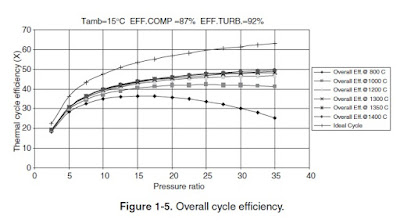WE'RE ALL POWERED THROUGH TURBINES - TURBINES | HYDRO | GAS | STEAM | WIND | TURBINES
GAS TURBINE PERFORMANCE (HISTORICAL) BASIC INFORMATION
HISTORICAL PERFORMANCE OF GAS TURBINES
The aerospace engines have been the leaders in most of the technology in the gas turbine. The design criteria for these engines was high reliability, high performance, with many starts and flexible operation throughout the flight envelope.
The engine life of about 3500 hours between major overhauls was considered good. The aerospace engine performance has always been rated primarily on its thrust/weight ratio.
Increase in engine thrust/weight ratio is achieved by the development of high-aspect ratio blades in the compressor as well as optimizing the pressure ratio and firing temperature of the turbine for maximum work output
per unit flow.
The Industrial Gas Turbine has always emphasized long life and this conservative approach has resulted in the Industrial Gas Turbine in many aspects giving up high performance for rugged operation. The Industrial Gas Turbine has been conservative in the pressure ratio and the firing temperatures.
This has all changed in the last 10 years; spurred on by the introduction of the “Aero-Derivative Gas Turbine” the industrial gas turbine has dramatically improved its performance in all operational aspects.
This has resulted in dramatically reducing the performance gap between these two types of gas turbines. The gas turbine to date in the combined cycle mode is fast replacing the steam turbine as the base load provider of electrical power throughout the world.
This is even true in Europe and the United States where the large steam turbines were the only type of base load power in the fossil energy sector. The gas turbine from the 1960s to the late 1980s was used only as peaking power in those countries.
It was used as base load mainly in the “developing countries” where the need for power was increasing rapidly so that the wait of three to six years for a steam plant was unacceptable.
Figures 1-3 and 1-4 show the growth of the Pressure Ratio and Firing Temperature.
The growth of both the Pressure Ratio and Firing Temperature parallel each other, as both growths are necessary to achieving the optimum thermal efficiency.
The increase in pressure ratio increases the gas turbine thermal efficiency when accompanied with the increase in turbine firing temperature. Figure 1-5 shows the effect on the overall cycle efficiency of the increasing pressure ratio and the firing temperature.
The increase in the pressure ratio increases the overall efficiency at a given temperature, however increasing the pressure ratio beyond a certain value at any given firing temperature can actually result in lowering the overall cycle efficiency.
In the past, the gas turbine was perceived as a relatively inefficient power source when compared to other power sources. Its efficiencies were as low as 15% in the early 1950s. Today its efficiencies are in the 45–50% range, which translates to a heat rate of 7582 BTU/kW-hr (8000 kJ/kW-hr) to 6824 BTU/kW-hr (7199 kJ/kW-hr).
The limiting factor for most gas turbines has been the turbine inlet temperature. With new schemes of cooling using steam or conditioned air, and breakthroughs in blade metallurgy, higher turbine temperatures have been achieved. The new gas turbines have fired inlet temperatures as high as 2600◦F (1427 ◦C), and pressure ratios of 40:1 with efficiencies of 45% and above.
Subscribe to:
Post Comments (Atom)



No comments:
Post a Comment